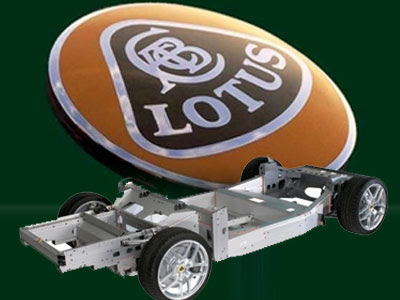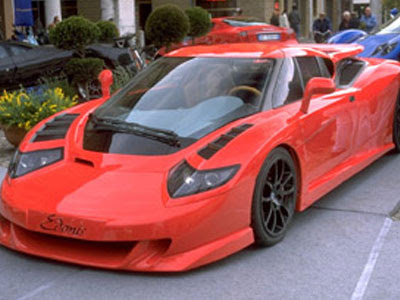Showing posts with label Prototype. Show all posts
Showing posts with label Prototype. Show all posts
Thursday, May 20, 2010
2011 Lotus Esprit Sports Car will be a wholly different Beast powered by a 4.4 liter V8 engine
0 comments Posted by org at 6:21 AMThe guys over at AutoCar have caught the upcoming Lotus Esprit testing in cold-snowy weather of Sweden. After running some DVLA records and matching the license plate, AutoCar has learned that the prototype is powered by a 4.4 liter V8 engine. Lotus sources have previously said that BMW may be the supplier for Lotus’ 2011 Esprit.It’s possible that the new Lotus Esprit will carry the 4.4 liter twin-turbo V8 engine from the new BMW X6, but will most likely be tuned to develop 500 horsepower.Currently the 4.4 liter twin-turbo from V8 produces 400 horsepower. The engine is also expected to be used in other BMW models including the X5 and the 7-Series. Lotus engineers will most probably re-work the engine management to reach numbers closer the Nissan GT-R and the Porsche 911 Turbo.
According to Lotus insiders, the next-gen Elise will arrive sometime in early 2011 followed by an all-new V8-powered Esprit in 2012.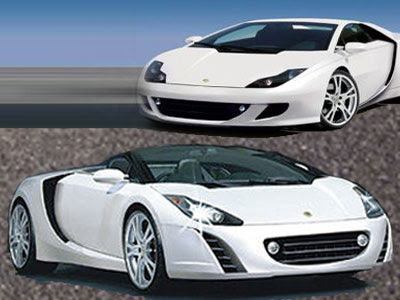 ..............................2011 Lotus Esprit Sports Car
..............................2011 Lotus Esprit Sports Car
 ..............................2011 Lotus Esprit Sports Car
..............................2011 Lotus Esprit Sports CarThe 2011 Elise will likely be built upon an evolved version of the current model’s extruded-aluminium underpinnings and continue the same formula that’s made the pint-sized sportscar a track day fave, but the Esprit will be a wholly different beast.
While the new Elise is all but locked in, the Esprit project is very much dependent on whether Lotus can sell enough Evoras to fund it. The timeline for the Esprit is also at the mercy of the global economic situation, with Lotus likely to delay the Esprit and forge ahead with a far less costly drop-top Evora if the recession persists much longer.
If it launches on time, the Esprit could be Lotus’ best hope of gaining a much larger share of the sports car market.
There are speculations stating that the 500bhp V10 powerplant can be the source of power for the Lotus Esprit, which will be released in 2012.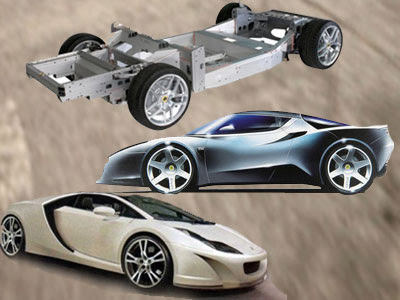 ..............................2011 Lotus Esprit Sports Car
..............................2011 Lotus Esprit Sports Car
 ..............................2011 Lotus Esprit Sports Car
..............................2011 Lotus Esprit Sports CarThe engine is currently being used in the Lexus LF-A, a car that has not yet been launched itself. Being connected with the Japanese carmaker Toyota, Lotus has access to its entire range of parts and components, as well as powerplants from the Lexus line. This points to the likelihood of an Esprit flagship, costing more than ?100,000, equipped with the compact 8500rpm V10 unit (to rival the Lamborghini Gallardo), including a less expensive variant equipped with the 5-liter, 417bhp V8 from the Lexus IS-F and an entry-level model coming with a Lotus-tuned direct-injection Toyota V6 unit that can come up with 300bhp.
Although a V8 or a V10 unit would definitely boost the profile of Lotus, there is also a possibility of an Eco Esprit. Lotus is moving forwards with more efficient products with lightweight engineering and its keen interest in alternative fuels and hybrid solutions. This is also underline by its partnership with the electric car manufacturer Tesla.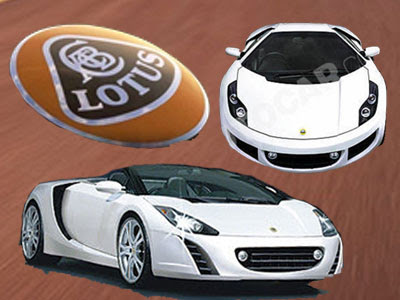 ..............................2011 Lotus Esprit Sports Car
..............................2011 Lotus Esprit Sports Car
 ..............................2011 Lotus Esprit Sports Car
..............................2011 Lotus Esprit Sports CarThe Esprit was inspired by the larger bonded and extruded aluminum chassis of the recently launched Evora, the rear section of which have been developed to accommodate both transversely and longitudinally fitted engines. Although the Lotus has shown that it can develop a new model in a short time (the Evora, for example, was developed in 27 months), the work on the Esprit will only reach its maximum when the Evora is being swept out of showrooms in the UK, Europe and US. It is the Malaysians who are funding the Evora project, with the persuasion of Lotus CEO Mike Kimberley.
Labels: Concept Car, Lotus, Lotus Esprit, Prototype, Sports Car, V10, V8
Thursday, November 19, 2009
2011 Lotus Esprit Sports Car will be a wholly different Beast powered by a 4.4 liter V8 engine
0 comments Posted by org at 8:05 AMThe guys over at AutoCar have caught the upcoming Lotus Esprit testing in cold-snowy weather of Sweden. After running some DVLA records and matching the license plate, AutoCar has learned that the prototype is powered by a 4.4 liter V8 engine. Lotus sources have previously said that BMW may be the supplier for Lotus’ 2011 Esprit.It’s possible that the new Lotus Esprit will carry the 4.4 liter twin-turbo V8 engine from the new BMW X6, but will most likely be tuned to develop 500 horsepower.Currently the 4.4 liter twin-turbo from V8 produces 400 horsepower. The engine is also expected to be used in other BMW models including the X5 and the 7-Series. Lotus engineers will most probably re-work the engine management to reach numbers closer the Nissan GT-R and the Porsche 911 Turbo.
According to Lotus insiders, the next-gen Elise will arrive sometime in early 2011 followed by an all-new V8-powered Esprit in 2012. ..............................2011 Lotus Esprit Sports Car
..............................2011 Lotus Esprit Sports Car
 ..............................2011 Lotus Esprit Sports Car
..............................2011 Lotus Esprit Sports CarThe 2011 Elise will likely be built upon an evolved version of the current model’s extruded-aluminium underpinnings and continue the same formula that’s made the pint-sized sportscar a track day fave, but the Esprit will be a wholly different beast.
While the new Elise is all but locked in, the Esprit project is very much dependent on whether Lotus can sell enough Evoras to fund it. The timeline for the Esprit is also at the mercy of the global economic situation, with Lotus likely to delay the Esprit and forge ahead with a far less costly drop-top Evora if the recession persists much longer.
If it launches on time, the Esprit could be Lotus’ best hope of gaining a much larger share of the sports car market.
There are speculations stating that the 500bhp V10 powerplant can be the source of power for the Lotus Esprit, which will be released in 2012. ..............................2011 Lotus Esprit Sports Car
..............................2011 Lotus Esprit Sports Car
 ..............................2011 Lotus Esprit Sports Car
..............................2011 Lotus Esprit Sports CarThe engine is currently being used in the Lexus LF-A, a car that has not yet been launched itself. Being connected with the Japanese carmaker Toyota, Lotus has access to its entire range of parts and components, as well as powerplants from the Lexus line. This points to the likelihood of an Esprit flagship, costing more than ?100,000, equipped with the compact 8500rpm V10 unit (to rival the Lamborghini Gallardo), including a less expensive variant equipped with the 5-liter, 417bhp V8 from the Lexus IS-F and an entry-level model coming with a Lotus-tuned direct-injection Toyota V6 unit that can come up with 300bhp.
Although a V8 or a V10 unit would definitely boost the profile of Lotus, there is also a possibility of an Eco Esprit. Lotus is moving forwards with more efficient products with lightweight engineering and its keen interest in alternative fuels and hybrid solutions. This is also underline by its partnership with the electric car manufacturer Tesla. ..............................2011 Lotus Esprit Sports Car
..............................2011 Lotus Esprit Sports Car
 ..............................2011 Lotus Esprit Sports Car
..............................2011 Lotus Esprit Sports CarThe Esprit was inspired by the larger bonded and extruded aluminum chassis of the recently launched Evora, the rear section of which have been developed to accommodate both transversely and longitudinally fitted engines. Although the Lotus has shown that it can develop a new model in a short time (the Evora, for example, was developed in 27 months), the work on the Esprit will only reach its maximum when the Evora is being swept out of showrooms in the UK, Europe and US. It is the Malaysians who are funding the Evora project, with the persuasion of Lotus CEO Mike Kimberley.
Labels: 2011, 2012, Concept Car, Lotus, Lotus Esprit, Prototype, Sports Car, V10, V8
Thursday, November 5, 2009
Lamborghini "Concept S" Supersportscar, The "Concept S" is equipped with a powerful V10 engine.
0 comments Posted by org at 10:37 PMThe Lamborghini "Concept S" design study premiered at this year's Geneva Motorshow as an extreme and spectacular expression of the Lamborghini brand.
The House of the Raging Bull has shown the first driveable prototype of the Lamborghini "Concept S" at the Monterey Concorso Italiano and at the Pebble Beach Concours d'Elegance in the USA.It was created at the Centro Stile Lamborghini in Sant'Agata Bolognese by Luc Donckerwolke, who drew inspiration from the classic single-seater racing cars of the past.The astonishing amount of public interest at the Geneva Motor Show prompted the decision to build a driveable prototype in order to further gauge potential customer demand.
The driveable "Concept S" prototype has only changed slightly compared to the original design study. For example, the so-called "saute-vent" windscreens were re-designed for homologation reasons. The look of the car results even more extreme than the original.
The aerodynamics of the "Concept S" have been optimised thanks to front and rear spoilers and a large rear diffuser. An electronically controlled, retractable central rear view mirror allows the driver to see what is happening behind the car - when required!
The House of the Raging Bull has shown the first driveable prototype of the Lamborghini "Concept S" at the Monterey Concorso Italiano and at the Pebble Beach Concours d'Elegance in the USA.
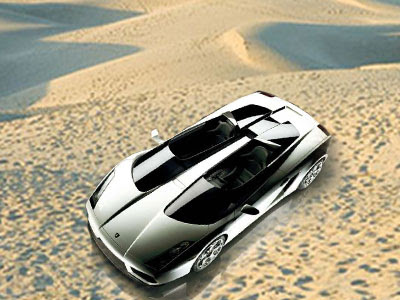 ..............................Lamborghini "Concept S"
..............................Lamborghini "Concept S"
The Lamborghini "Concept S" design study premiered at this year's Geneva Motorshow as an extreme and spectacular expression of the Lamborghini brand. It was created at the Centro Stile Lamborghini in Sant'Agata Bolognese by Luc Donckerwolke, who drew inspiration from the classic single-seater racing cars of the past.
The driveable "Concept S" prototype has only changed slightly compared to the original design study. For example, the so-called "saute-vent" windscreens were re-designed for homologation reasons. The look of the car results even more extreme than the original.
The driveable "Concept S" prototype has only changed slightly compared to the original design study. For example, the so-called "saute-vent" windscreens were re-designed for homologation reasons. The look of the car results even more extreme than the original.
"The "Concept S" represents everything that Lamborghini stands for. It is extreme, uncompromising and Italian," commented Stephan Winkelmann, President and CEO of Automobili Lamborghini. "A production decision has not yet been made, though we were encouraged by the positive response to the driveable prototype at both Monterey and Pebble Beach."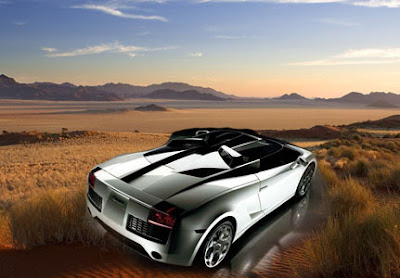 ..............................Lamborghini "Concept S"
..............................Lamborghini "Concept S"
 ..............................Lamborghini "Concept S"
..............................Lamborghini "Concept S"The aerodynamics of the "Concept S" have been optimised thanks to front and rear spoilers and a large rear diffuser. An electronically controlled, retractable central rear view mirror allows the driver to see what is happening behind the car - when required!
The House of the Raging Bull has shown the first driveable prototype of the Lamborghini "Concept S" at the Monterey Concorso Italiano and at the Pebble Beach Concours d'Elegance in the USA.
Classic single-seaters did not have a traditional windscreen, but utilised the „saute-vent" in order to direct air over the head of the driver. In the "Concept S", these devices divide the cabin into two distinct compartments, giving the car an aggressive and futuristic look.
They also create a space between them that acts as an additional air inlet for the engine, which is positioned behind the seats. And like the Gallardo, which serves as the basis for this stunning supersportscar, the "Concept S" is equipped with a powerful V10 engine. ..............................Lamborghini "Concept S"
..............................Lamborghini "Concept S"The Lamborghini "Concept S" design study premiered at this year's Geneva Motorshow as an extreme and spectacular expression of the Lamborghini brand. It was created at the Centro Stile Lamborghini in Sant'Agata Bolognese by Luc Donckerwolke, who drew inspiration from the classic single-seater racing cars of the past.
The driveable "Concept S" prototype has only changed slightly compared to the original design study. For example, the so-called "saute-vent" windscreens were re-designed for homologation reasons. The look of the car results even more extreme than the original.
Labels: Concept Car, Design Car, Lamborghini, Prototype, Spors Car, Supercars, Supersport Car
Thursday, October 15, 2009
Yamaha OX99-11 Supercar 3498 cc V12
Yamaha initially approached a German company to come up with some designs for the supercar. However Yamaha dismissed the proposals as they were considered to similar to existing supercars. IAD were at this point hired to continue work on the project. In 1992 IAD came with an initial version of the OX99-11.
The Yamaha OX99-11 was a supspercar designed by IAD, an English engineering consultancy, and Yamaha subsidiary Yilon Technology.
While the Yamaha OX99-11 was originally slated to appear in 1994, the roots of the OX99-11 project began in 1989 when Yamaha began competing in Formula One, later this spawned the desire to create a supercar based on Formula One technology.
Despite the fact the Formula One team was less than competitive, a new engine called the OX99 appeared in 1991, helping to give the new car a name.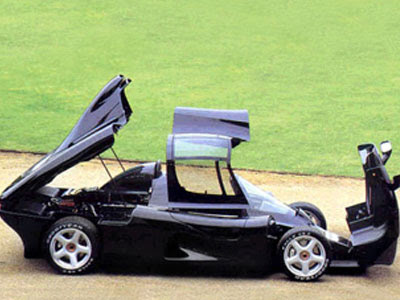
The new car featured an unusual and somewhat ugly design, features like the prominent front spoiler, tandem seating, cockpit shaped roof and protruding engine scoop stood out from other vehicles. Other features of the car which were rather extreme included the carbon fiber chassis and OX99 engine which were borrowed from the F1 car.
Budget disagreements meant the Yamaha OX99-11 project was taken from IAD and handed over to Ypsilon Technology, who were given 6 months to finish the project. A further blow to the project was came in the form of a financial crisis which hit Japan and it was decided that there wouldn't be enough buyers capable of handing over the vast sums of money needed to buy the car. In 1994 the Yamaha OX99-11 project was axed. By this point only 3 prototypes had been constructed.
The Yamaha OX99-11 was a supspercar designed by IAD, an English engineering consultancy, and Yamaha subsidiary Yilon Technology.
While the Yamaha OX99-11 was originally slated to appear in 1994, the roots of the OX99-11 project began in 1989 when Yamaha began competing in Formula One, later this spawned the desire to create a supercar based on Formula One technology.
Despite the fact the Formula One team was less than competitive, a new engine called the OX99 appeared in 1991, helping to give the new car a name.

Yamaha OX99-11 Supercar 3498 cc V12
The new car featured an unusual and somewhat ugly design, features like the prominent front spoiler, tandem seating, cockpit shaped roof and protruding engine scoop stood out from other vehicles. Other features of the car which were rather extreme included the carbon fiber chassis and OX99 engine which were borrowed from the F1 car.
Budget disagreements meant the Yamaha OX99-11 project was taken from IAD and handed over to Ypsilon Technology, who were given 6 months to finish the project. A further blow to the project was came in the form of a financial crisis which hit Japan and it was decided that there wouldn't be enough buyers capable of handing over the vast sums of money needed to buy the car. In 1994 the Yamaha OX99-11 project was axed. By this point only 3 prototypes had been constructed.
Labels: Design Car, Prototype, Spors Car, Supercars, Yamaha
Monday, October 12, 2009
8c Competizione Alfa Romeo
Designed and developed at the Alfa Romeo Style Centre, the 8c Competizione prototype pays homage to road racing Alfa's of the 30s and 40s which bore the 8c signature, while 'Competizione' refers to the 6C 2500 Competizione, a car driven by Fangio and Zanardi in the Mille Miglia race of 1950. (see 2006 BMW Mille Miglia concept)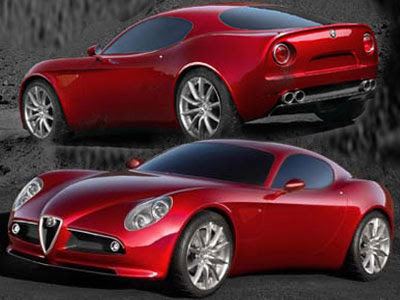

8c Competizione Alfa Romeo
The Alfa 8c is a retro design powered by a Maserati V8 engine
Alfa Romeo are well known for producing flamboyant and beautifully styled cars, sometimes overlooking reliability. The 8c Competizione concept takes this philosophy to another level, and is one of the most stunning designs to come from the Italian manufacturer.
The flowing graceful lines of the 8c Competizione are a trait shared with another Alfa concept, the Nuvola. Both cars are inspired and shaped by Alfa Romeo models of the past, and their aesthetic design reflects this retro influence.
Labels: Alfa Romeo, Concept Car, Design Car, Prototype, Sport Car
Wednesday, October 7, 2009
New Sports Audi R15 Tdi Petit Le Mans Race
Britain’s Allan McNish (pictured) came tantalisingly close to achieving his fifth Petit Le Mans race victory at Road Atlanta on Saturday (26 Sep) and maintaining Audi’s 100% winning record in the annual American sportscar endurance race since the German manufacturer’s debut in 2000.
The Dumfries-born double Le Mans 24 Hour race winner and Italian co-driver Dindo Capello led for the opening 4hrs before the Scotsman suffered two spins and dropped to third place on the treacherously wet and slippery track in Georgia - moments before the race went in to a Safety Car period and was ultimately stopped with almost five hours run.
After a further delay of almost four hours and near constant heavy rain, organisers decided not to re-start the event which in any case was limited to 10 hours or 1,000-miles, leaving the McNish/Capello diesel-engined Audi R15 TDI classified third, a mere 3.465secs behind the winning Peugeot (Franck Montagny/Stephane Sarrazin).
The McNish/Capello Audi had started from third place on the 27-car grid but McNish swept in to the lead on the opening lap. The “sister” R15 TDI of Lucas Luhr/Marco Werner began from fourth place, a position the German duo were classified in, one lap down on the top-three, when the race was declared over. Meanwhile the McNish/Capello Audi won the efficiency award “Michelin GreenX Challenge” – a trophy awarded to the most environmentally friendly car.
Audi unexpectedly contested a third race of the year to collect further race information about its new sports-prototype in preparation for the Le Mans 24 Hours next June.
The Dumfries-born double Le Mans 24 Hour race winner and Italian co-driver Dindo Capello led for the opening 4hrs before the Scotsman suffered two spins and dropped to third place on the treacherously wet and slippery track in Georgia - moments before the race went in to a Safety Car period and was ultimately stopped with almost five hours run.
After a further delay of almost four hours and near constant heavy rain, organisers decided not to re-start the event which in any case was limited to 10 hours or 1,000-miles, leaving the McNish/Capello diesel-engined Audi R15 TDI classified third, a mere 3.465secs behind the winning Peugeot (Franck Montagny/Stephane Sarrazin).
The McNish/Capello Audi had started from third place on the 27-car grid but McNish swept in to the lead on the opening lap. The “sister” R15 TDI of Lucas Luhr/Marco Werner began from fourth place, a position the German duo were classified in, one lap down on the top-three, when the race was declared over. Meanwhile the McNish/Capello Audi won the efficiency award “Michelin GreenX Challenge” – a trophy awarded to the most environmentally friendly car.
Audi unexpectedly contested a third race of the year to collect further race information about its new sports-prototype in preparation for the Le Mans 24 Hours next June.
Labels: Audi, Diesel Car, Diesel Engine Car, Engine Car, Prototype, Sports Car
Monday, January 12, 2009
B. Engineering Edonis Super Car by Jean Marc Borel
The Edonis cannot be described as a beautiful car, but it certainly eye catching. Its angular, complicated lines crash awkwardly together in a chaotic fashion, this trend is evident from almost every angle. The headlights give the impression of tiredness, or even depression.
The Edonis supercar is a creation of B. Engineering, a company run by Jean Marc Borel. The Edonis was intended as a demonstration of the design and prototype abilities of his company. The B. Engineering Edonis is a genuine supercar with a 0-60 time under 4 seconds, and a maximum speed of 225 mph.
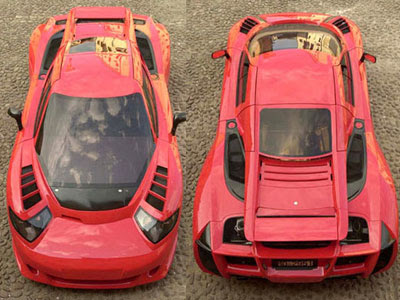
B. Engineering Edonis Super Car by Jean Marc Borel
The Edonis has little to be sad about. Twin turbochargers feed a 3.7 litre V-12 engine to create a whopping 680 bhp at 8,000 rpm. All this power is run through a six-speed manual gearbox.
Using a monocoque built from carbon fiber the Edonis is very strong and light. All the cosmetic exterior body panels are aluminum. To reduce weight further aluminum brake calipers are used.
To save even more space and weight the Edonis rides on Michelin PAX run-flat tires, this means a spare wheel is surplus to requirement.
Labels: Design Car, Edonis, Prototype, Super Car
Monday, January 5, 2009
Spiess TC 522 prototype supercar twin-turbo V8
The Spiess TC 522 was a supercar prototype from 1992. It was created by a Spiess, a German company better known for creating industrial electrical transformers.
The TC 522 was powered by a mid-mounted 5.7 litre, twin-turbo V8. The transmission was handled by a 6 speed manual driving the rear wheels. The Spiess TC 522 had a carbon-fibre composite body. Due to its high price, and a worldwide economic slow down, the TC 522 never left the prototype stage.
The TC 522 was powered by a mid-mounted 5.7 litre, twin-turbo V8. The transmission was handled by a 6 speed manual driving the rear wheels. The Spiess TC 522 had a carbon-fibre composite body. Due to its high price, and a worldwide economic slow down, the TC 522 never left the prototype stage.
Subscribe to:
Posts (Atom)
